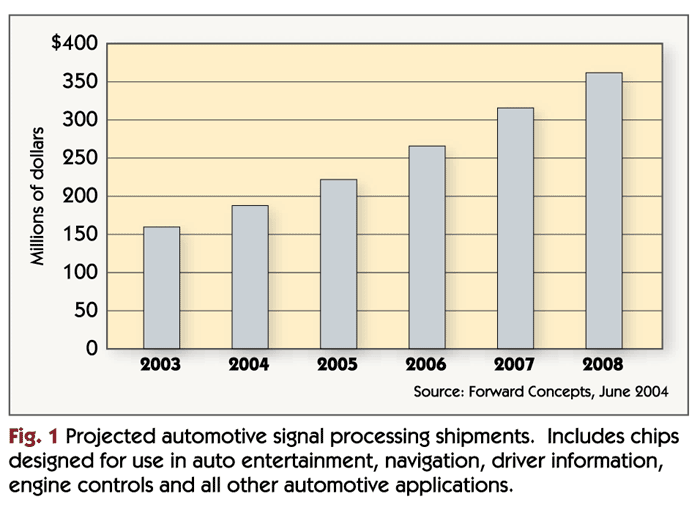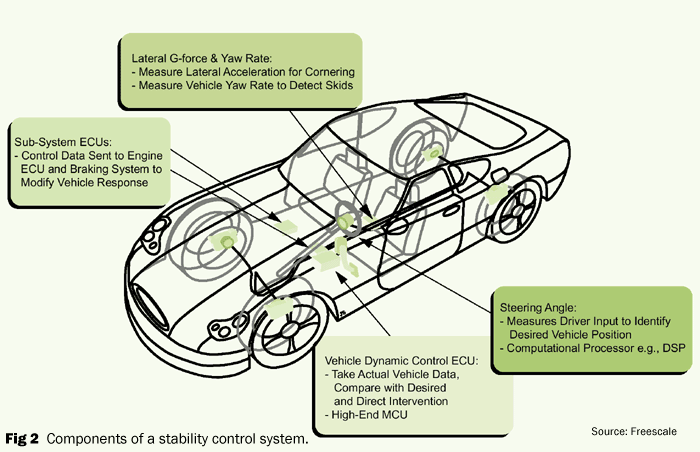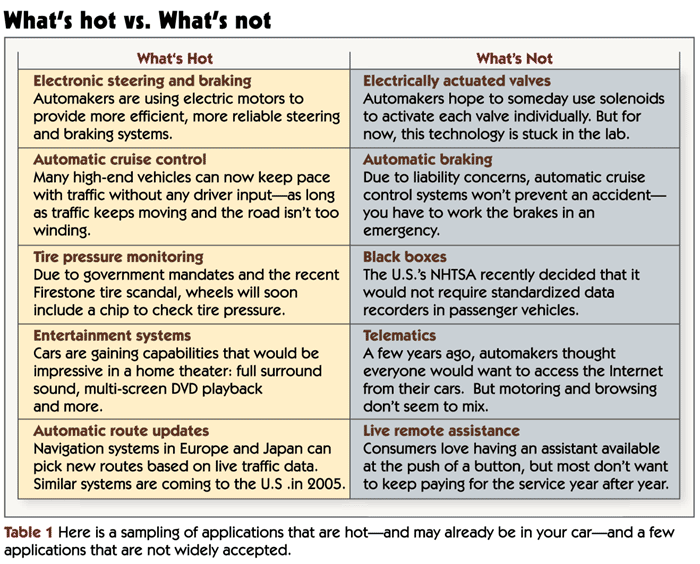Trends in Automotive Signal Processing
Signal processing is pervasive in today’s vehicles, in applications ranging from engine controllers to entertainment systems. With annual automotive sales now at roughly 60 million units worldwide, it's clear that automotive applications represent a major market for signal processing technology. And as shown in Figure 1, the market for automotive signal processing is expected to grow at a healthy pace.

In this article, we explore four automotive signal processing application areas: engine and transmission control, safety and convenience, electronic steering and braking, and “infotainment.” For each application area, we survey current and forthcoming uses of signal processing technology, focusing on a few uses that are particularly noteworthy in each application area. We also highlight the forces driving these applications, such as government regulations, cost pressures, and the desire for differentiation among automakers.
Engine and transmission control
Signal processing is becoming more prevalent in engines and transmissions for several reasons. Government clean-air mandates are pushing manufacturers to design more fuel-efficient engines and transmissions. Fuel efficiency is also important to consumers, particularly in locations where fuel prices are high. And consumers also want strong performance. In parallel with these rising demands, automakers want to reduce their costs and shorten their design cycles. Signal processing can help achieve all of these goals.
Engine controllers
Engines have employed electronic controllers for many years. Until recently, these controllers relied heavily on static look-up tables to determine how to adjust engine parameters. Today, engine controllers use more sophisticated algorithms, such as those used to detect engine knock.
“Knocking” is uncontrolled fuel combustion that is detrimental to emissions, fuel economy, and engine longevity. Traditionally, engine controllers used conservative pre-defined settings to ensure knocking did not occur. However, engines operate most efficiently when they are on the edge of knocking, so this strategy limits engine power. To solve this problem, modern engine controllers employ signal processing algorithms to detect the warning signs of knock. This allows engines to operate on the edge of knocking.
Controllers are also beginning to use differential equations that model engine behavior. These equations allow the engine controller to fine-tune its response to engine conditions, rather than relying on a limited set of look-up table parameters. The model-based approach also reduces the amount of time spent on engine calibration. In the look-up table approach, calibration involves testing the engine under a broad range of conditions. This process requires an enormous amount of time and money. Determining the parameters for a model-based controller requires significantly less testing.
Engine controllers are also becoming more complex as they begin to control more aspects of the engine. In most current engines, the valves are operated by a purely mechanical system. Valve timing, however, is starting to become electronically controlled. Future engines may even have fully electronic valve trains where each valve is actuated by a solenoid. These increasingly sophisticated controls will call for additional signal processing.
Signal processing is also used to provide smooth control of various electric motors. One interesting motor-control application is the electrically boosted turbocharger. Engines can achieve higher efficiency through the use of a turbocharger, but turbochargers tend to suffer from “lag.” That is, there is usually a noticeable delay between the driver pressing the accelerator and the turbocharger delivering the additional power. By adding an electric motor to the turbocharger, engine designers can eliminate this lag.
Sophisticated electric motors are also used in hybrid vehicles that are powered by the combination of an internal combustion engine and an electric motor. Current vehicles have a single electric motor, but future vehicles may use separate motors for each wheel, greatly increasing the per-vehicle demand for motor controllers. Control of electric motors will also be important for the fuel-cell powered vehicles currently under development.
Transmissions
Transmissions are increasingly dependent on sophisticated signal processing algorithms. For example, several vehicles now offer computer-controlled “manual” transmissions that eliminate the need for a clutch pedal. These systems typically use a model-based approach—similar to the approach used in modern engine controllers—to determine how and when to make transitions between gears. The models use information about friction, gear synchronization speeds, and other transmission parameters to perform shifting operations. Electronic systems can shift much faster than human drivers when top performance is required, and they can execute ultra-smooth shifts under less aggressive driving conditions.
Cost reduction
In addition to providing better performance and efficiency, signal processing technology can reduce costs in engine and transmission controllers. For example, these controllers can use digital signal processing instead of analog signal conditioning. Analog circuitry carries significant costs and has limited flexibility. For example, analog signal conditioning hardware designed for a four-cylinder engine might be useless for a six-cylinder engine. By using digital signal processing, the same engine controller can be adapted for different engine architectures, just by changing the software. This reduces development costs and also reduces the number of parts an automaker must stock. And performing signal conditioning in the digital domain reduces costs by reducing the parts count for an engine.
Engines typically contain many sensors, and the outputs of these sensors are often interrelated. By using signal processing techniques, engine designers can remove some sensors and derive their readings from those of the remaining sensors. This is important because sensors are some of the most expensive components in an engine.
Safety and convenience
Safety and convenience applications are a major driver of signal processing technology in vehicles. Consumers often rank safety as one of their highest priorities when shopping for a car. As a result, automakers are keen to differentiate their offerings on the basis of safety features.
Airbags are one of the most common electronically controlled safety systems. As automakers add more airbags and more sensors to their vehicles, airbag controllers require increasingly sophisticated algorithms. For example, automakers want to improve airbag performance by compensating for the position of the occupants. One way to detect occupant position is to use machine vision—a technique that requires serious signal processing horsepower.
Anti-lock brakes are another commonplace safety application. Anti-lock brakes systems sense when a wheel is skidding (“locked”) during braking, and temporarily release the brake from that wheel. In recent years, antilock brake systems have been extended to become vehicle stability control systems, as illustrated in Figure 2. Stability control systems determine when the driver is loosing control of the vehicle; the latest stability systems even measure yaw to detect whether the vehicle is edging towards a rollover. If the driver is about to loose control, the system modifies engine power and braking as needed to keep the vehicle on course. A few systems also stiffen the suspension to counteract roll. These stability systems analyze a large number of input signals and require quite sophisticated processing.

Because of liability concerns, many of the latest automotive safety technologies have been deployed as “convenience” features rather than “safety” features. For example, several high-end cars now offer adaptive cruise control. Adaptive cruise control uses radar or laser to sense the distance to the vehicle ahead, and the speed of that vehicle. The system then adapts its speed to the pace of the vehicle in front of it. This allows drivers to use cruise control in moderately heavy traffic.
Such a system could be extended to prevent collisions by braking when the leading vehicle came to a halt. However, today’s systems do not offer this feature because of liability concerns. Instead, these systems prepare the car when a collision is imminent. For example, the cruise control system may signal the seat controller to move the seats into an upright position to minimize injuries.
Electronic steering and braking
Electronic steering and braking are also emerging signal processing applications. Electronic steering is becoming increasingly popular because electronic steering systems are more efficient than hydraulic steering systems. The added efficiency leads to noticeable fuel efficiency gains, particularly for smaller vehicles. Electronic systems are also smaller—and hence easier to fit into an engine bay—faster to install, and more reliable than hydraulic systems.
Basic systems simply replace the traditional belt-driven hydraulic pump with an electrically-driven hydraulic pump. More sophisticated systems completely replace the hydraulic system with a direct electric motor assist. Such systems use signal processing algorithms to achieve precise motor control.
Forthcoming systems go even further by coordinating the electric power steering with the vehicle stability system. Such systems detect when the vehicle is deviating from the desired trajectory. In such a situation, the system can make small modifications to the steering angle. Looking further into the future, the steering system may become completely electronic, with no mechanical connection between the driver and the wheels.
Some high-end braking systems are also replacing hydraulics with electric motors. These systems use servomotors to push the brake pads against the brake rotors. As with electronic steering, these systems require signal processing algorithms to achieve precise motor control.
Infotainment
Last but not least, signal processing is found throughout automotive entertainment and information systems, which are collectively known as “infotainment” systems. Signal processing is used for communications tasks such as transmitting cellular telephone and Bluetooth signals. It is also used for audio tasks such as equalization and MP3 decoding. Recently, signal processing has begun to be used for video tasks such as DVD playback. To learn more about the uses of signal processing in audio and video, please see the January and March 2004 editions of Inside[DSP].
See Table 1 for descriptions of a few additional applications that are attracting attention, as well as a few applications that seem to be stuck in neutral.

Looking down the road
As governments tighten emissions requirements and consumers demand high performance and efficiency, the need for sophisticated power train algorithms will grow. Governments and consumers are also likely to continue demanding ever-more-sophisticated safety features. In the face of these demands, automakers are sure to continue replacing mechanical systems with electronics. And consumers are clearly ready to spend money on automotive entertainment and information products and services. In short, the road ahead looks promising for automotive signal processing applications.
Some new vehicles also feature lane-departure warning systems, which determine when the vehicle leaves a lane unintentionally. The first of these systems to be deployed on U.S. passenger vehicles, which will be available later this year, uses machine vision. If unintentional lane departure is detected—if the driver changes lanes without first using the turn signal, for example—these systems warn the driver through an audible alarm or other means. Currently, U.S.-bound systems do not attempt to prevent lane departure. However, systems that prevent lane departure are now available in Japan—a country that is considerably less litigious than the U.S.


Add new comment